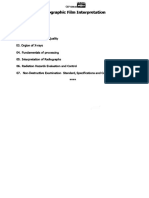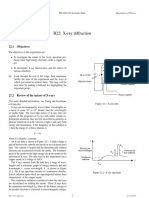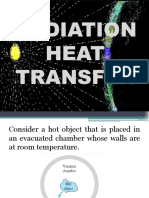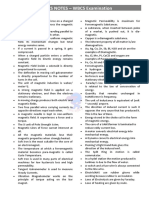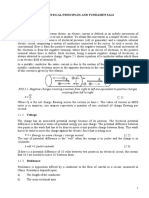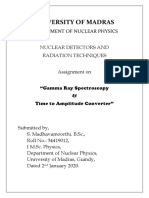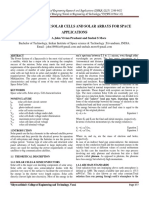اصطلاحات فیزیک
اصطلاحات فیزیک
Uploaded by
sahand soleymaniCopyright:
Available Formats
اصطلاحات فیزیک
اصطلاحات فیزیک
Uploaded by
sahand soleymaniOriginal Title
Copyright
Available Formats
Share this document
Did you find this document useful?
Is this content inappropriate?
Copyright:
Available Formats
اصطلاحات فیزیک
اصطلاحات فیزیک
Uploaded by
sahand soleymaniCopyright:
Available Formats
Glossary
absolute zero lowest possible temperature: –273°C or 0 K asteroid belt region of the Solar System, between the
orbits of Mars and Jupiter, which is occupied by a very large
absorber takes in heat or radiation
number of small rocky bodies
acceleration change of velocity per unit time atmospheric pressure force per unit area produced by the
acceleration of free fall g; for an object near to the weight of air acting on a surface
surface of the Earth, this is approximately constant and is atom tiny constituent of matter
approximately 9.8 m/s2
atomic bomb produces an uncontrolled chain reaction
accurate close to the true value
availability able to be used at all times
activity the average number of atoms which decay per 2 πr
second of a sample of radioactive material average orbital speed n =
T
advantages of high-voltage transmission of electricity average speed distance moved/time taken
(i) lower power loss in transmission cables and background radiation ever-present radiation resulting from
(ii) lower currents in cables so thinner/cheaper cables cosmic rays from outer space and radioactive materials in
can be used rocks, the air, buildings
air resistance frictional force opposing the motion of a balance instrument used for measuring mass
body moving in air
balanced forces no resultant force on an object
alpha particles α-particles; radiation consisting of two
4 barometer instrument which allows atmospheric pressure to
protons and two neutrons (helium nuclei) (2 He)
be measured
alternating current a.c.; the direction of current flow battery consists of two or more electric cells
reverses repeatedly
beam (1) many rays of light (2) rectangular-shaped rod
alternator a.c. generator
beta particles β-particles; radiation consisting of
0
ammeter instrument used to measure electric current high-speed electrons ( −1 e)
ampere A; unit of current bimetallic strip equal lengths of two different metals
amplitude height of crest (or depth of trough) of a wave, riveted together
measured from the undisturbed position of the medium biofuels fuel obtained from plants or animal dung and
carrying the wave sewage
analogue continuously varying biogas a mixture of methane and carbon dioxide produced
from animal and human waste
angle of incidence angle between incident ray and the
normal to a surface boiling temperature temperature at which bubbles of
vapour form in a liquid
angle of reflection angle between reflected ray and the
normal to a surface braking distance distance over which brakes applied before
vehicle brought to rest
angle of refraction angle between refracted ray and the
normal to a surface brushes in a motor or generator; carbon blocks which act
as electrical contacts
anode positively charged electrode
carbon dating a method used to calculate the age of
anomalous value a reading that falls outside the normal or carbon-based materials, such as wood, by measuring the
expected range of measurements amount of the radioactive isotope carbon-14 remaining in
area of a circle πr 2 where r is the radius of the circle the material and using the half-life of carbon-14 to work
out when the object was alive
area of a square or rectangle length × breadth
cathode negatively charged electrode
area of a triangle base × height/2
cathode rays beams of high-speed electrons
armature coil and core of an electric motor
cathode ray oscilloscope (CRO) instrument that allows
asteroid small pieces of rock which orbit the Sun, mostly in rapidly changing voltages to be displayed and analysed on
the asteroid belt between Mars and Jupiter a screen
340
9781398310605_BM.indd 340 30/03/21 12:32 PM
Glossary
centimetre cm; 10–2 m converging light bends inwards
centre of gravity the point at which all of an object’s coulomb C; unit of charge
weight can be considered to be concentrated
count-rate counts/second
centre-zero meter an instrument used to detect small
crest of a wave maximum amplitude of a wave
currents and p.d.s
critical a chain reaction becomes critical when on average
centripetal force force acting towards the centre which
each fission results in another fission event, so that the
keeps a body moving in a circular path
reaction is sustained
chain reaction a set of nuclear reactions which are started
critical angle angle of incidence which produces an angle
by a single fission
of refraction of 90°
chemical energy energy stored (for example in food and
cubic centimetre cm3; unit used to measure volume
fuel) which can be released by chemical reactions
cubic metre m3; SI unit of volume
circuit breaker used instead of a fuse to break a circuit
when the current exceeds a certain value current flow of electric charges; symbol I, measured in
ampere (A)
cloud chamber a device which makes the paths of α-, β-
and γ-radiation visible daughter nuclei nuclides produced in fission or radioactive
decay from a single ‘parent’ nuclide
comet a ball of ice and dust that orbits the Sun
deceleration a negative acceleration; velocity decreases as
compression a region in a longitudinal wave where the
time increases
particles are closer together than normal
degrees Celsius °C; unit of temperature
condensation change of a gas or vapour to a liquid
density mass per unit volume
conduction flow of thermal energy through matter from
places of higher temperature to places of lower temperature dependent variable quantity whose value depends on that
without movement of the matter as a whole of another
conductor material which allows thermal energy or diffraction spreading of a wave at the edges of an obstacle
electrons to flow easily
digital using discrete values only
constant having the same value
direct current d.c.; electrons flow in one direction only
constant of proportionality the ratio of two variables
direction of a magnetic field at a point the direction of
which are directly proportional to each other
the force on the N pole of a magnet at that point
contact force force between two objects touching each
direction of an electric field at a point the direction of
other
the force on a positive charge at that point
continuous ripples a wave
dispersion separation of white light into its component
control rod rod made of boron, a material that absorbs colours
neutrons, which can be lowered into a nuclear reactor to
displacement distance moved in a stated direction
slow down or stop the chain reaction
displacement–distance graph graph of the displacement
control variable variable that is kept constant in an
from their undisturbed position of the particles
experiment
transmitting a wave, plotted against their distance from
convection flow of thermal energy through a fluid from the source, at a particular instant of time
places of higher temperature to places of lower temperature
distance–time graph graph of distance on the vertical axis
by movement of the fluid itself
plotted against time on the horizontal axis
convection currents streams of warm moving fluids
diverging light spreads out
convector warms air using convection currents
drag resistive force caused by the motion of an object
conventional current direction in which a positive charge through a fluid; the force acts in the opposite direction to
would flow in a circuit the motion of the object
341
9781398310605_BM.indd 341 30/03/21 12:32 PM
Glossary
dwarf planet any object that orbits a star that has enough energy density energy/volume
mass and a gravitational field strength high enough to have
energy sources materials and resources from which energy
formed a spherical shape but too low to attract and clear
can be produced
the area around it of other, smaller objects
energy transfer change of store or location of energy
dynamic friction frictional force acting on a body moving
at a constant speed equilibrium when there is no resultant force and no
dynamo d.c. generator resultant moment on an object
echo reflection of a sound wave evaporation loss of vapour from a liquid surface at a
temperature below the boiling temperature of the liquid
efficiency (useful energy output/energy input) × 100%;
(useful power output/power input) × 100% excited atom atom in which electrons have jumped from an
inner to an outer orbit
effort force required to lift a weight
expansion increase in size
elastic energy see strain energy
extension change in length of a body being stretched
elastic limit for extensions beyond the elastic limit,
a material will not return to its original length when factors affecting the magnitude of an induced e.m.f.
unloaded; it is permanently stretched and the law of e.m.f increases with increases of: (i) the the rate of change
proportionality no longer applies of the magnetic field or the rate of cutting of magnetic
field lines, (ii) the number of turns on the coil
electric current the charge passing a point per unit time
(current I = Q/t where Q is the charge flowing past a field line line which shows the direction of an electric,
particular point in time t) magnetic or gravitational field at each point
electric cell a device that transfers stored chemical energy filament thin coil of wire which can transfer the energy
as an electric current carried by an electric current to thermal and light energy
electric field a region of space where an electric charge (as in a lamp)
experiences a force due to other charges fission the break-up of a large nucleus into smaller parts
electric force force between electric charges Fleming’s left-hand (motor) rule when the thumb and
electrode emitter or collector of electric charges first two fingers of the left hand are held at right angles to
each other with the first finger pointing in the direction of
electromagnet temporary magnet produced by passing an the magnetic field and the second finger in the direction of
electric current through a coil of wire wound on a soft iron the current then the thumb points in the direction of the
core thrust on a wire
electromagnetic induction the production of a p.d. across fluid a liquid or gas
a conductor when it moves through a magnetic field or is at
rest in a changing magnetic field fluorescent emitting light when struck by ultraviolet
radiation or electrons
electromagnetic radiation radiation resulting from
electrons in an atom undergoing an energy change; all focal length distance between the optical centre and the
types travel in a vacuum at 3 × 108 m/s (the speed of light) principal focus of a lens
and obey the wave equation focus bring beams to a point
electromotive force (e.m.f.); the electrical work done by a force a push or pull on a body
source in moving unit charge around a complete circuit
0 fossil fuels coal, oil and natural gas formed from the
electron e ; negatively charged elementary particle
−1 remains of plants and animals which lived millions of
electrostatic energy energy stored by a charged object years ago
electrostatic induction production of charge on a forward bias p.d. connected across a diode such that it has
conductor when a charge is brought close to it a low resistance and conducts
emitter gives out heat or radiation free-body diagram diagram showing the relative
magnitude and direction of the forces acting on an object
energy may be stored as kinetic, gravitational potential,
chemical, elastic (strain), nuclear, electrostatic and internal freezing temperature temperature at which a liquid
(thermal) changes to a solid
342
9781398310605_BM.indd 342 30/03/21 12:32 PM
Glossary
frequency number of complete oscillations per second independent variable quantity whose value does not
depend on that of another
friction force which opposes one surface moving, or trying
to move, over another surface induction motor a.c. motor
fulcrum pivot inertia the mass of an object resists change from its state
fundamental frequency main frequency of rest or motion
fuse a short length of wire which melts when the current in infrared radiation electromagnetic waves emitted by hot,
the circuit exceeds a certain value; it protects the circuit but not glowing, bodies
from carrying a large current insulator material which does not allow thermal energy or
fusion the union of light nuclei into a heavier one electrons to flow easily
galaxy made up of many billions of stars intensity measure of the magnitude of a quantity such as
sound, light or electric field
gamma radiation γ-radiation; high-frequency, very
penetrating electromagnetic waves internal energy energy of the molecules in a body (both
potential and kinetic); thermal energy
gas turbine gas is used to turn the blades of a rotor
inversely proportional two variables are inversely
Geiger–Müller tube GM tube; detects radiation proportional if their product is a constant
generator electricity-producing machine ionosphere electrically charged particles in the upper
geostationary satellite satellite which travels at the atmosphere
same speed as that at which the Earth rotates and so
ionisation process by which an atom or molecule becomes
appears to be stationary at a particular point above the
an ion
Earth’s surface
ionisation energy the minimum energy required to remove
geothermal energy energy obtained from hot rocks below
an electron from an atom
the Earth’s surface is used to heat water to steam which is
then used to drive a turbine and generate electricity ions charged atoms or molecules which have lost or gained
one or more electrons so that they are no longer neutral
gravitational field a region where the Earth exerts a force
on a body isotopes of an element, are atoms which have the same
number of protons but different numbers of neutrons in the
gravitational field strength the force per unit mass
nucleus
gravitational potential energy g.p.e.; energy a body has
due to its height above the Earth’s surface (ΔEp = mgΔh) joule J; SI unit of energy
half-life the time taken for half the nuclei of that isotope joulemeter used to measure the energy transferred by an
in any sample to decay appliance
hard in magnetic terms, a permanent magnet made from a kelvin K; SI unit of temperature; a kelvin has the same size
material such as steel as a degree Celsius but 0°C = 273 K
hazards associated with using mains electricity supply kilogram kg; SI unit for mass
include damaged insulation, overheated cables, damp kilometre km; 103 m
conditions, excess current from overloaded plugs, extension
leads, single and multiple sockets kilowatt kW; 103 W
heat exchanger transfers heat from one fluid to another kilowatt-hour kWh; the energy used by a
1 kW electrical appliance in 1 hour;
hertz Hz; units of frequency (cycles per second) 1 kWh = 1000 J/s × 3600 s = 3 600 000 J = 3.6 MJ
Hooke’s law extension ∝ stretching force kinetic energy Ek; energy a body has due to its motion
hydroelectric energy flow of water from a high to a low (mv2/2)
level is used to drive a water turbine connected to an
law of reflection the angle of incidence is equal to the
electricity generator
angle of reflection
image likeness of an object
length greatest dimension of an object; SI unit is the
impulse force × time for which force acts metre (m)
343
9781398310605_BM.indd 343 30/03/21 12:32 PM
Glossary
Lenz’s law the effect of the current produced by an induced medical ultrasound imaging technique used to image
e.m.f. is to oppose the change producing it internal organs of the body using the reflection of
ultrasonic pulses
light-dependent resistor LDR; semiconductor device
in which the electrical resistance decreases when the megawatt MW; 106 W
intensity of light falling on it increases
melting temperature temperature at which a solid changes
light emitting diode LED; semiconductor device which to a liquid
emits light when it is forward biased but not when it is
meniscus curved liquid surface
reverse biased
metre m; SI unit for length
light-year used to measure astronomical distances; the
distance travelled in (the vacuum of) space by light in one micrometre µm; 10–6 m
year
microphone transfers the energy carried by sound waves to
limit of proportionality the point at which the load- an electrical current
extension graph becomes non-linear
microwaves radio waves with a wavelength of a few cm
limits of audibility the approximate range of frequencies
Milky Way the spiral galaxy to which our Solar System
audible to humans, 20 Hz to 20 000 Hz
belongs. The Sun is a star in this galaxy and other stars
linear conductor conductor which obeys Ohm’s law that make up this galaxy are much further away from the
linear magnification the ratio of image length to object Earth than the Sun is from the Earth
length millimetre 10–3 m
linearly values lie along a line minor planet any object that orbits a star that does not
line of best fit straight line drawn on a graph so that data have a large enough mass for gravitational attraction to
points are scattered evenly above and below the line have pulled it into a spherical shape
line of force see field line moderator graphite core of a nuclear reactor which slows
down fission neutrons
live wire connected to a high p.d.
molecule combination of atoms
load weight
moment of a force moment = force × perpendicular
longitudinal wave direction of vibration of particles of the distance from pivot
transmitting medium is parallel to the direction of travel of
the wave momentum mass × velocity
long sight distant objects are seen clearly but close objects motor rule see Fleming’s left-hand rule
appear blurred multimeter an instrument which can be used to measure
loudspeaker transfers the energy carried by an electrical a.c or d.c. currents and voltages and also resistances
current to sound waves musical notes produced by regular vibrations
luminous object which makes its own light mutual induction occurs when a changing current in one
magnetic field a region of space where a magnet experiences coil produces a changing current in a nearby coil as a result
a force due to other magnets or an electric current of electromagnetic induction
magnetic force force between magnets nanometre nm; 10 −9 m
magnetic materials materials that can be magnetised by a National Grid network of electricity transmission lines
magnet; in their unmagnetised state they are attracted by
negative charges repel other negative charges, but
a magnet
negative charges attract positive charges
mass a measure of the quantity of matter in an object at
neutral point point at which magnetic fields cancel
rest relative to an observer
neutral wire connected to earth
mass number A; number of protons and neutrons (nucleons)
in the nucleus of an atom neutron uncharged particle found in the nucleus of an atom
(except that of hydrogen)
mechanical waves to and fro vibration of the particles of a
transmitting medium newton N; SI unit of force
344
9781398310605_BM.indd 344 30/03/21 12:32 PM
Glossary
Newton’s first law of motion a body stays at rest, or if particle model (also called the kinetic particle model) a
moving continues to move with uniform velocity, unless an model in which every material is made of large numbers of
external force makes it behave differently extremely small moving particles (atoms, molecules, ions
and electrons); it is used to explain the different properties
Newton’s second law of motion force = mass × acceleration
of solids, liquids and gases
Newton’s third law of motion when object A exerts a force
pascal Pa; SI unit of pressure 1 Pa = 1 N/m2
on object B, then object B exerts an equal and opposite
force on object A period time for one complete oscillation (1/frequency)
noise produced by irregular vibrations permanent magnets made of steel, retain their magnetism
non-luminous object which does not make its own light; it perpendicular at 90°
may reflect light from a luminous source phase vibrating particles transmitting a wave are in phase
non-magnetic materials materials that cannot be if they are moving in the same direction and have the
magnetised and are not attracted by a magnet same displacement; if this is not the case, they are out
of phase
non-ohmic device which does not obey Ohm’s law
photon tiniest quantity of electromagnetic energy
non-renewable cannot be replaced when used up
pitch frequency of a sound wave
normal line which is perpendicular to a surface
polar near the north or south pole of the Earth
nuclear energy energy stored in the nuclei of atoms
positive charges repel other positive charges, but positive
nuclear fuels radioactive materials such as uranium, used charges attract negative charges
in the core of a nuclear reactor where the energy stored as
nuclear energy is released and used to heat water potential difference p.d.; the work done by a unit charge
passing through a component
nucleon proton or neutron
potential divider variable resistor connected so that the
nucleon number A; number of protons and neutrons in the p.d. applied to a device can be changed
nucleus
potential energy energy a body has because of its position
nucleus dense core of an atom containing protons and or condition
neutrons
potentiometer resistor whose resistance can be varied
nuclide atom of an element characterised by the mass
number A and the proton number Z power the work done per unit time and the energy
transferred per unit time
octave notes are an octave apart if the frequency of one
note is twice that of the other powers of ten way of writing numbers; index gives number
of times number must be multiplied by 10
ohm Ω; unit of resistance
precision of a measurement is the smallest scale division
ohmic conductor conductor which obeys Ohm’s law on the instrument used to make the measurement
Ohm’s law the current through a metallic conductor is pressure the force per unit area
directly proportional to the p.d. across its ends if the
primary main, most important
temperature and other conditions are constant
principal axis line through the optical centre of a lens at
optical centre centre of a lens
right angles to the lens
orbit curved path, such as that taken by a planet moving
principal focus (focal point) point on the principal axis
around the Sun
of a lens to which light rays parallel to the principal axis
parallax error reading error that occurs if scale marking not converge, or appear to diverge from
viewed perpendicularly
principle of conservation of energy energy cannot be
parallel lines with the same direction created or destroyed; it is always conserved
parallel circuit components are connected side by side principle of conservation of momentum when two or
and the current splits into alternative paths and then more bodies act on one another, the total momentum
recombines; current from the source is larger than the of the bodies remains constant, provided no external forces
current in each branch act
345
9781398310605_BM.indd 345 30/03/21 12:32 PM
Glossary
principle of moments when a body is in equilibrium, the and move their feet from the accelerator pedal to the brake
sum of the clockwise moments about any point equals the pedal
sum of the anticlockwise moments about the same point
real image an image which can be formed on a screen
progressive wave travelling wave carrying energy from one
rectifier changes a.c. to d.c.
place to another
redshift shift in the wavelengths of light from distant
proportional two variables are proportional if their ratio is
galaxies towards longer wavelengths (the red end of the
a constant
spectrum)
proton positively charged particle found in the nucleus of
refraction bending of rays when they pass from one
an atom
medium to another
proton number Z; number of protons in the nucleus
refractive index n; a number that describes the bending of
protractor a device used to measure and draw angles a ray of light when it passes from one medium into another;
pulse a few cycles of a wave sin i 1
refractive as n =
index
defined n = i is the angle of incidence and r
, where
sin r sin c
pumped storage electricity generated at off-peak periods
is the angle of refraction
is used to pump water from a low-level reservoir to a high-
level one relative motion motion of one object with respect to another
quality or timbre of a sound is determined by the number relay electromagnetic switch
and strength of the overtones present
renewable can be replaced; cannot be used up
radial along a radius
resistance opposition of a conductor to the flow of electric
radiant emits radiation current; symbol R, measured in ohms (Ω)
radiation transfer of thermal energy from one place to resistance of a metallic wire directly proportional to
another by electromagnetic waves its length and inversely proportional to its cross-sectional
area
radio waves electromagnetic waves with the longest
wavelength resistor conductor designed to have resistance
radioactive material which emits α-, β- or γ-radiation resultant force the rate of change in momentum per unit
time
radioactive decay the emission of α-, β- or γ-radiation
from unstable nuclei reverberation combination of a sound wave and its echo
which acts to prolong the sound
radioisotope isotope of an element which is radioactive
reverse bias p.d. connected across a diode such that it has
radionuclide see radioisotope
a high resistance and does not conduct
radiotherapy use of ionising radiation to treat cancer
rheostat variable resistor connected so that the current in
random irregular, erratic or haphazard a circuit can be changed
random errors scatter (variation) in measured values right angle 90°
range the difference between the maximum and minimum right-hand grip rule if the fingers of the right hand grip a
values of a set of measurements, or on the scale of a solenoid in the direction of the conventional current, the
measuring instrument thumb points to the N pole
rarefaction a region in a longitudinal wave where the right-hand screw rule if a right-handed screw moves
particles are further apart than normal forwards in the direction of the conventional current, the
direction of rotation of the screw gives the direction of the
ratemeter instrument which counts the number of current
magnetic field
pulses/second (often used with a GM tube)
rotor blades or electromagnets on a rotating shaft
ray direction of the path in which light travels
scalar a quantity which has magnitude only
reaction time the time that passes between seeing
something happen and reacting to it, for example the time scaler instrument which counts current pulses (often used
taken by the driver of a vehicle to react to an emergency, with a GM tube)
346
9781398310605_BM.indd 346 30/03/21 12:32 PM
Glossary
second s; SI unit of time stator (or diaphragm) set of fixed blades (or fixed coils in
an alternator)
secondary coming later; of less importance
steam turbine steam is used to turn the blades of a rotor
semiconductor diode electronic device which allows
current to flow in one direction but not the other stopping distance total distance travelled in the time it
sensitivity response of a device to a change in input takes to stop a vehicle; equals thinking distance + braking
distance
series circuit components connected one after the other;
the current is the same at each point in a series circuit storage heater stores thermal energy using ‘off-peak’
electricity and releases it later
short sight close objects are seen clearly but distant
objects appear blurred strain energy energy stored in a compressed spring or
elastic material; also called elastic energy
significant figures number of figures to which a value is
given; they indicate the accuracy of a measurement stretching force force causing a body to change shape
sliding friction frictional force acting on a body moving at systematic error error introduced by the measuring device
a constant speed (the system)
slip rings rings attached to the ends of the coil of an a.c. tangent a line touching, but not intersecting, a curve
generator which rotate with the coil and to which electrical temperature determines the direction in which thermal
contact is made energy flows; kinetic theory regards temperature as a
soft in magnetic terms, material such as iron which is easily measure of the average kinetic energy of the molecules
magnetised and demagnetised of the body
solar cells convert sunlight into electricity temporary magnets made of soft iron, lose their
magnetism easily
solar energy energy from the Sun
tension force in a string or spring being stretched
solar panels convert sunlight into thermal energy
terminal velocity constant velocity reached when the air
Solar System one star (the Sun) and all the planets, resistance upwards equals the downward weight of a falling
moons that orbit the planets, and other objects including body
asteroids and comets that orbit the Sun
thermal energy energy of the molecules in a body
solenoid long cylindrical coil of wire
thermal power station thermal energy is used to turn
sonar an echo technique which enables the depth of an water into steam to drive a turbine and generate electricity
object to be found using ultrasonic waves
thermistor semiconductor device in which the electrical
spectrum band of colours produced when white light is resistance decreases when the temperature increases
separated into its component parts
thermometer device for measuring temperature
specific heat capacity the energy required per unit mass
per unit temperature increase thermonuclear fusion the combination of light nuclei into
a heavier nucleus in a reaction which takes place at a very
speed distance travelled per unit time
high temperature (for example in the Sun)
speed–time graph graph of speed on the vertical axis
thermostat a device which keeps the temperature of a room
plotted against time on the horizontal axis
or appliance constant
split-ring commutator split ring of copper which rotates
thinking distance distance travelled during reaction time
with the coil of an electric motor; it enables the current
of driver (before brakes applied)
through the coil to be reversed every half-turn
thoron radioactive gas which emits α-particles
spring constant force per unit extension; it is the constant
of proportionality in Hooke’s law thrust sudden driving force causing motion in a particular
standard form (standard notation) writing numbers using direction
powers of ten tidal energy flow of tidal water from a high to a low level
starting friction (also called static friction) maximum value used to generate electricity
of a frictional force which occurs just as a body starts to move timbre see quality
347
9781398310605_BM.indd 347 30/03/21 12:32 PM
Glossary
time duration; SI unit is the second (s) vector a quantity which has both magnitude and direction
timebase on a cathode ray oscilloscope, controls the time velocity speed in a given direction; change in displacement
interval displayed on the horizontal axis of the screen per unit time
total internal reflection occurs when a light ray does virtual image an image which cannot be formed on a screen
not cross the boundary between two media; it is totally volt V; unit of p.d. or e.m.f.
reflected at the boundary
voltage p.d.; measured in volts (V)
tracer radioisotope injected into a system or the human
body; the motion or concentration of the isotope can be voltmeter instrument used to measure p.d.
monitored, for example with a GM tube volume of a cylinder πr 2 × h, where r is the radius and h is
transformer two coils (primary and secondary) wound on a the height of the cylinder
soft iron core which allow an alternating p.d. to be changed 4
volume of a sphere πr3, where r is the radius of the
from one value to another sphere 3
transverse wave direction of vibration is perpendicular to watt SI unit of power; 1 W = 1 J/s
the direction of travel of the wave
3
wave energy rise and fall of sea waves used to generate
tritium 1 H
H; isotope of hydrogen with one proton and two electricity
neutrons in the nucleus
wave equation v = fλ
ultrasound sound wave with a frequency greater than
20 kHz waveform shape of a wave
ultraviolet radiation electromagnetic waves having shorter wavefront in two dimensions, it is a line on which the
wavelengths than light particles transmitting the wave are vibrating in phase;
the crests of waves in a ripple tank are wavefronts. A line
unbalanced forces there is a resultant force on an object drawn perpendicular to a wavefront is a ray
uniform having the same value wavelength distance between successive crests of a wave
uniform acceleration constant acceleration weight a gravitational force on an object that has mass
uniform velocity constant velocity wind turbines convert wind energy into electricity
vacuum a space from which all particles have been removed work measure of amount of energy transferred.
vaporisation change of a liquid to a vapour Work done = force × distance moved in the direction of the
force. SI unit is the joule (J)
variable quantity that can be changed
X-rays electromagnetic waves with a shorter wavelength
variable resistor resistor whose resistance can be changed than ultraviolet radiation
variation of magnetic field strength the magnetic field Y-gain on a cathode ray oscilloscope, controls the
decreases with distance from a current-carrying wire and amplification of the input p.d.
varies around a solenoid
348
9781398310605_BM.indd 348 30/03/21 12:32 PM
You might also like
- Physics GlossaryDocument21 pagesPhysics GlossaryKing VaibhavNo ratings yet
- Fire Safety Full ReportDocument30 pagesFire Safety Full ReportNoor Asni100% (1)
- Fuji Af-300 MiniDocument127 pagesFuji Af-300 MinimvhernanNo ratings yet
- UB Glossary - For - PhysicsDocument10 pagesUB Glossary - For - Physics龙澄No ratings yet
- All Definitions For Physics 0625 &0972Document8 pagesAll Definitions For Physics 0625 &0972Ahmed SherifNo ratings yet
- Physics 11 GlossaryDocument7 pagesPhysics 11 GlossaryHan DevNo ratings yet
- GlossaryDocument8 pagesGlossarymaanyaytaccNo ratings yet
- Radiographic Film InterpretationDocument53 pagesRadiographic Film Interpretationlinh vu100% (1)
- GCSC Physics GlossaryDocument8 pagesGCSC Physics GlossarysmeenaNo ratings yet
- Alpha 7Document2 pagesAlpha 7irenellemedallaNo ratings yet
- garg1993Document13 pagesgarg1993Sam LawrenceNo ratings yet
- B22: X-Ray Diffraction: 22.1 ObjectivesDocument5 pagesB22: X-Ray Diffraction: 22.1 ObjectivesDaniel DolingNo ratings yet
- Radiation Heat TransferDocument31 pagesRadiation Heat TransferMark Anthony Salazar ArcayanNo ratings yet
- Ultrasonic Sensor For Level MeasurementDocument34 pagesUltrasonic Sensor For Level MeasurementAshish RawatNo ratings yet
- Physics DictionaryDocument3 pagesPhysics DictionaryAnn Shen ThianNo ratings yet
- Radiation Electromagnetic 20Document23 pagesRadiation Electromagnetic 20KENNYNo ratings yet
- EDMDocument34 pagesEDMHrishikeshNo ratings yet
- Report LilLev A Micro Ultrasonic Single Axis Acoustic LevitationDocument3 pagesReport LilLev A Micro Ultrasonic Single Axis Acoustic LevitationtaddtareeNo ratings yet
- Exam QuestionsDocument10 pagesExam QuestionsJohnNo ratings yet
- Life in The Universe, 4th Edition-Pearson (2017) (Dragged)Document10 pagesLife in The Universe, 4th Edition-Pearson (2017) (Dragged)Jason SmithNo ratings yet
- UV-VIS Spectrophotometry: A Brief Background To SpectrophotometryDocument15 pagesUV-VIS Spectrophotometry: A Brief Background To SpectrophotometrySiddh BhattNo ratings yet
- 100 Physics One Liner For WBCS 2020Document2 pages100 Physics One Liner For WBCS 2020Saurav BandyopadhyayNo ratings yet
- Presented By-Aarzoo Pathak (Final YearDocument52 pagesPresented By-Aarzoo Pathak (Final YearSandeep VermaNo ratings yet
- ObjectivesDocument40 pagesObjectivesEunielyn SecretoNo ratings yet
- Chapter 2: Basic Concepts and Parameters of Plasma Physics: KT T T Ne NDocument13 pagesChapter 2: Basic Concepts and Parameters of Plasma Physics: KT T T Ne NRoy VeseyNo ratings yet
- Ionization ChamberDocument42 pagesIonization ChamberRabia AbdullahNo ratings yet
- DC Sputtering of Copper TargetDocument28 pagesDC Sputtering of Copper TargetStudy illustrationNo ratings yet
- 1989 - Haroche Kleppner - Phys Today - CQED PDFDocument8 pages1989 - Haroche Kleppner - Phys Today - CQED PDFkrisNo ratings yet
- Radiation Physics By. MCSRRTDocument39 pagesRadiation Physics By. MCSRRTAngelica Montalbo NavaNo ratings yet
- Term Paper of RF and MicrowaveDocument8 pagesTerm Paper of RF and MicrowavekaranNo ratings yet
- Supplementary - ContentDocument5 pagesSupplementary - ContentKalaiarasu SubramanianNo ratings yet
- NDT GlossaryDocument55 pagesNDT GlossaryRajeev KumarNo ratings yet
- Glossary A Level PhysicsDocument10 pagesGlossary A Level Physicsdanishali1090No ratings yet
- Fundamentals of Radiation DosimetryDocument17 pagesFundamentals of Radiation DosimetryGeoff OwusuNo ratings yet
- GM CounterDocument7 pagesGM CounterBidhan DasNo ratings yet
- NASA CR-1785, Radiation Effects Design HDBKDocument475 pagesNASA CR-1785, Radiation Effects Design HDBKRGK77No ratings yet
- 3001 ElecDocument10 pages3001 ElecZsaZsa FetalinoNo ratings yet
- GmE 202 Lecture 2 Physical Principles of Remote Sensing PDFDocument56 pagesGmE 202 Lecture 2 Physical Principles of Remote Sensing PDFJashley VillalbaNo ratings yet
- ATOMSDocument17 pagesATOMSsabatsuhani74No ratings yet
- Aberration: Weak Anthropic PrincipleDocument43 pagesAberration: Weak Anthropic PrinciplenewprocessNo ratings yet
- Lecture-9 SIMS NDTDocument61 pagesLecture-9 SIMS NDTKo Lin Lin KoNo ratings yet
- Quizlet SpectraDocument2 pagesQuizlet SpectracfmonarquiaNo ratings yet
- MT 2Document77 pagesMT 2safeer ahmadNo ratings yet
- Chapter 1 - WavesDocument8 pagesChapter 1 - WavesQiun LeeNo ratings yet
- Training On RT - ASNT Level IIDocument72 pagesTraining On RT - ASNT Level IIAguara OghenevwedeNo ratings yet
- Gamma Ray Spectroscopy Assignment PDFDocument13 pagesGamma Ray Spectroscopy Assignment PDFMADHAVA MOORTHINo ratings yet
- Radiac Cuerpo Negro - SearsDocument5 pagesRadiac Cuerpo Negro - SearsOswaldo BastidaNo ratings yet
- Rad PhysDocument5 pagesRad PhysCarlos BustamanteNo ratings yet
- DefinitionsDocument4 pagesDefinitionsmbilalipk7No ratings yet
- Radiography Basics 1Document38 pagesRadiography Basics 1jayaramNo ratings yet
- PHYS1003 Cheat SheetDocument8 pagesPHYS1003 Cheat Sheetwin winwinNo ratings yet
- A2 Phy GlossaryDocument6 pagesA2 Phy GlossaryVersha VasdaniNo ratings yet
- Unit-5 Radiography: AdvantagesDocument23 pagesUnit-5 Radiography: AdvantagescandypranavNo ratings yet
- Maser Theory TownesDocument10 pagesMaser Theory TownesMauricio Alfredo Fuentes FloresNo ratings yet
- IAL Physics DefinitionsDocument5 pagesIAL Physics DefinitionsNayan KeraiNo ratings yet
- Testing of Space Solar Cells & Solar Arrays For Space ApplicationsDocument8 pagesTesting of Space Solar Cells & Solar Arrays For Space ApplicationsJohn Vivian Prashant jp7vivianNo ratings yet
- Measuring Energy of X-Rays Using A Scintillation DetectorDocument5 pagesMeasuring Energy of X-Rays Using A Scintillation DetectorJagannath DasNo ratings yet
- International Journal of Heat and Mass Transfer: Y.-B. Chen, K.-H. TanDocument10 pagesInternational Journal of Heat and Mass Transfer: Y.-B. Chen, K.-H. TanyassinebouazziNo ratings yet
- ELEX Reviewer 1Document8 pagesELEX Reviewer 1chapatzNo ratings yet
- LRL Accelerators, The 184-Inch SynchrocyclotronFrom EverandLRL Accelerators, The 184-Inch SynchrocyclotronNo ratings yet
- Quota Bando e Allegati Ingegneria Contingentati 23 24 ENGLISHDocument30 pagesQuota Bando e Allegati Ingegneria Contingentati 23 24 ENGLISHsahand soleymaniNo ratings yet
- 2 Projectile Motion Challenge 1 SolutionDocument1 page2 Projectile Motion Challenge 1 Solutionsahand soleymaniNo ratings yet
- جزوه لاجیکDocument8 pagesجزوه لاجیکsahand soleymaniNo ratings yet
- Atomic Structure Multiple Choice QPDocument11 pagesAtomic Structure Multiple Choice QPsahand soleymaniNo ratings yet
- Can Spatial Training Improve Long Term ODocument12 pagesCan Spatial Training Improve Long Term Osahand soleymaniNo ratings yet
- Resistance: Leaving Cert Physics Long Questions 2018 - 2002Document19 pagesResistance: Leaving Cert Physics Long Questions 2018 - 2002Oheneba Kwadjo Afari DebraNo ratings yet
- Electrokinetics 2012 Propellantless Propulsion - Valone SPESIF Online Elsevier PDFDocument12 pagesElectrokinetics 2012 Propellantless Propulsion - Valone SPESIF Online Elsevier PDFThomas Valone100% (2)
- Reliability Issues GaN HEMTDocument4 pagesReliability Issues GaN HEMTSva KolisiNo ratings yet
- Docc 1988Document5 pagesDocc 1988swchen100% (2)
- JM Electro - Persamaan TransistorDocument4 pagesJM Electro - Persamaan TransistorAndi KaNo ratings yet
- Protective Relays 2Document51 pagesProtective Relays 2Tejas PendkalkarNo ratings yet
- Power Electronics Question Paper Part2Document1 pagePower Electronics Question Paper Part2vagoliyoNo ratings yet
- Periodical Test in Science 8Document3 pagesPeriodical Test in Science 8Eileen Joy Noceda88% (195)
- Models - Acdc.submarine Cable 01 IntroductionDocument64 pagesModels - Acdc.submarine Cable 01 Introductionisai.diaz2995No ratings yet
- Electric Current in ConductorsDocument31 pagesElectric Current in ConductorsthinkiitNo ratings yet
- Biosensors and Bioelectronics: Matti KaistiDocument12 pagesBiosensors and Bioelectronics: Matti Kaistiyomnayasmin100% (1)
- Robot Wiring GuideDocument27 pagesRobot Wiring Guidejohn blargNo ratings yet
- sg18 CurrentresistancedccircuitsDocument4 pagessg18 Currentresistancedccircuitsapi-317469538No ratings yet
- Modeling of The Dynamics of Rotors of An Energy Gas Turbine Installation Using An Analytical Method For Analyzing Active Magnetic Bearing CircuitsDocument6 pagesModeling of The Dynamics of Rotors of An Energy Gas Turbine Installation Using An Analytical Method For Analyzing Active Magnetic Bearing Circuitsshamiul himelNo ratings yet
- EI-04 Bridge 2024Document76 pagesEI-04 Bridge 2024Prashant BudarapuNo ratings yet
- Capacitence of Single Core CableDocument15 pagesCapacitence of Single Core CableAnant MomayaNo ratings yet
- Cat A1 SOP 04 Working On or Near Energized Electrical Equipment PDFDocument19 pagesCat A1 SOP 04 Working On or Near Energized Electrical Equipment PDFRached Ben AyedNo ratings yet
- Series: Chip Type, Extra Low ImpedanceDocument13 pagesSeries: Chip Type, Extra Low ImpedanceselocaNo ratings yet
- HVDC Transmission Systems: Electricity and New EnergyDocument79 pagesHVDC Transmission Systems: Electricity and New EnergyMary Morse100% (1)
- Blood Gas AnalyzerDocument36 pagesBlood Gas AnalyzerNabila Souza NugrahaNo ratings yet
- Introduction To Electrical Power System and FaultsDocument229 pagesIntroduction To Electrical Power System and FaultsLloyd R. Ponce100% (2)
- ElectricityDocument4 pagesElectricitySomeone 123No ratings yet
- Voltaic CellDocument32 pagesVoltaic CellMahijar Jarullhayati Hassan50% (2)
- Delhi Public School: Holiday Assignment Science StreamDocument24 pagesDelhi Public School: Holiday Assignment Science StreamShreyaNo ratings yet
- Choosing The Right PV VoltageDocument1 pageChoosing The Right PV Voltagedabs_orangejuiceNo ratings yet
- Technical SpecificationsDocument56 pagesTechnical SpecificationsTrajkoNo ratings yet
- Lab Report Number 06 Kirchofs Cicuit KCL and KVL Ohm LawDocument6 pagesLab Report Number 06 Kirchofs Cicuit KCL and KVL Ohm LawMuhAmmad AqiB ShAykhNo ratings yet
- Spec - 46 33kv VCB With CRP (24v)Document98 pagesSpec - 46 33kv VCB With CRP (24v)Dijo PaulNo ratings yet







